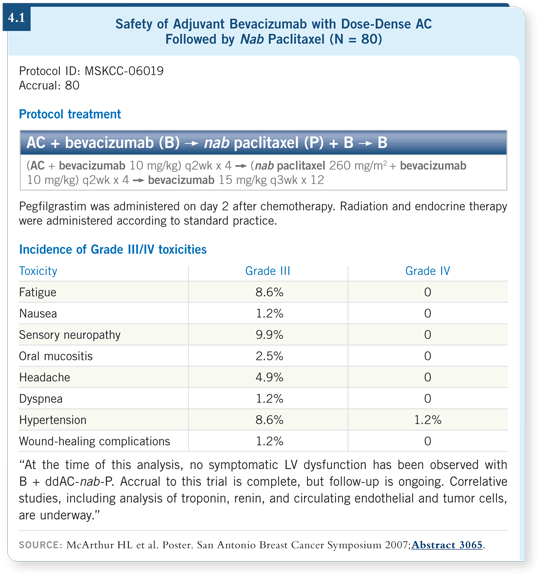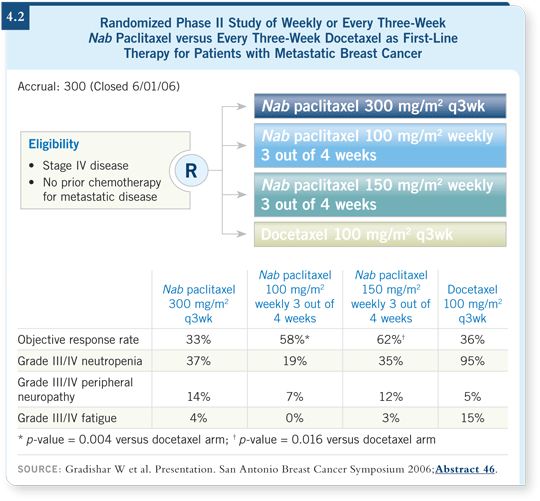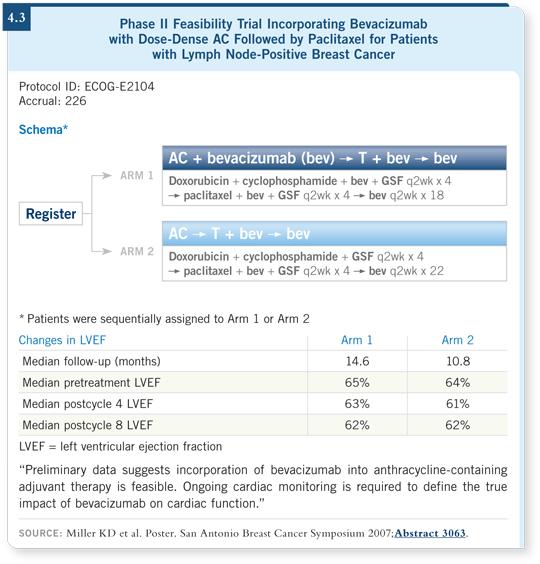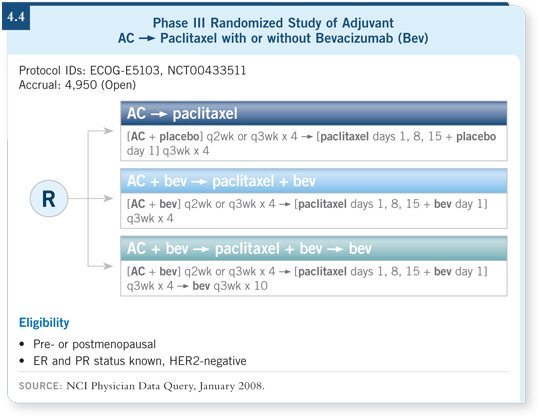
 |
||||||||

| Tracks 1-18 | ||||||||||||||||||||||||||||||||||||||
|
Select Excerpts from the Interview
Track 10
![]() DR LOVE: Kathy, would you comment on the analysis of
ECOG-E2100 with regard to VEGF genetic polymorphisms and
the effects of bevacizumab?
DR LOVE: Kathy, would you comment on the analysis of
ECOG-E2100 with regard to VEGF genetic polymorphisms and
the effects of bevacizumab?
![]() DR MILLER: We have been struggling with how to identify patients most
likely to benefit from bevacizumab — or any other anti-VEGF therapy. We
realized that five polymorphisms are in the VEGF ligand, the VEGF-A gene,
that somehow decrease VEGF signaling.
DR MILLER: We have been struggling with how to identify patients most
likely to benefit from bevacizumab — or any other anti-VEGF therapy. We
realized that five polymorphisms are in the VEGF ligand, the VEGF-A gene,
that somehow decrease VEGF signaling.
Eleven polymorphisms of the VEGF receptor 2 gene are unstudied, but at least one of them, according to computer modeling, affects the ATP binding domain, so one would expect it to have a significant impact on function.
When tumor blocks collected in the E2100 study were examined, two polymorphisms of the VEGF ligand were identified that seem to clearly influence the risk of toxicity, particularly hypertension (Schneider 2007). Patients who had neither polymorphism and who were homozygous for wild-type VEGF had a low rate of hypertension — in the single digits — whereas patients who were homozygous for one or both of those polymorphisms bore a risk of 40 percent or more.
![]() DR LOVE: Is there a relationship between hypertension and tumor response?
DR LOVE: Is there a relationship between hypertension and tumor response?
![]() DR MILLER: We haven’t found a relationship between hypertension and
response. A different VEGF polymorphism in the E2100 data, however, effects
or predicts improved overall survival in the bevacizumab-treated group.
DR MILLER: We haven’t found a relationship between hypertension and
response. A different VEGF polymorphism in the E2100 data, however, effects
or predicts improved overall survival in the bevacizumab-treated group.
It’s not purely a prognostic factor — it had no influence on overall survival in the paclitaxel-alone group, but it strongly predicted improved overall survival in the combination-therapy group, with a nice demonstration of a gene-dose effect.
We believe these polymorphisms are important and may help us predict which patients will have better outcomes with bevacizumab, and perhaps other VEGF-targeted therapies, and which patients may bear a greater risk of toxicity. We are still examining more samples and other polymorphisms, but we are sufficiently encouraged to include collecting genomic DNA in the adjuvant trial for this type of analysis.
![]() DR HUDIS: I find these data exciting. Although they don’t predict the
benefits of bevacizumab, being prepared to manage toxicities with this
agent — and maybe even the class of tyrosine kinase inhibitors (TKIs) —
will be important.
DR HUDIS: I find these data exciting. Although they don’t predict the
benefits of bevacizumab, being prepared to manage toxicities with this
agent — and maybe even the class of tyrosine kinase inhibitors (TKIs) —
will be important.
We have data on 75 patients treated with dose-dense AC followed by nab paclitaxel, all combined with bevacizumab in the adjuvant setting. I’m tempted to apply this analysis to that data set.
![]() DR LOVE: What have you seen so far in this adjuvant trial?
DR LOVE: What have you seen so far in this adjuvant trial?
![]() DR HUDIS: It’s a safety study, and the data are still maturing because some
patients are still completing the year of bevacizumab. At this point, we have
seen reasonable tolerance of this regimen, with a modest incidence of hypertension
and proteinuria (McArthur 2007; [4.1]).
DR HUDIS: It’s a safety study, and the data are still maturing because some
patients are still completing the year of bevacizumab. At this point, we have
seen reasonable tolerance of this regimen, with a modest incidence of hypertension
and proteinuria (McArthur 2007; [4.1]).
The detailed cardiac safety analysis is forthcoming. At this moment, it appears to be no more toxic than one would expect of an anthracycline-based regimen.
Tracks 12-13
![]() DR LOVE: Cliff, in your experience using paclitaxel and nab paclitaxel,
how much difference does it make to patients not to receive premedication
with steroids?
DR LOVE: Cliff, in your experience using paclitaxel and nab paclitaxel,
how much difference does it make to patients not to receive premedication
with steroids?

![]() DR HUDIS: Patients like not receiving the steroids. They sleep better and
experience less aggravation. However, I don’t believe nab paclitaxel is globally
less toxic than conventional paclitaxel.
DR HUDIS: Patients like not receiving the steroids. They sleep better and
experience less aggravation. However, I don’t believe nab paclitaxel is globally
less toxic than conventional paclitaxel.
![]() DR LOVE: How does the efficacy of nab paclitaxel compare to docetaxel or
paclitaxel?
DR LOVE: How does the efficacy of nab paclitaxel compare to docetaxel or
paclitaxel?
![]() DR HUDIS: Bill Gradishar reported on a randomized Phase II trial comparing
three different schedules of nab paclitaxel to docetaxel (Gradishar 2006; [4.2]).
This was a regimen-finding study, and it’s my understanding that they will
pick the winner to compare to docetaxel in a Phase III study.
DR HUDIS: Bill Gradishar reported on a randomized Phase II trial comparing
three different schedules of nab paclitaxel to docetaxel (Gradishar 2006; [4.2]).
This was a regimen-finding study, and it’s my understanding that they will
pick the winner to compare to docetaxel in a Phase III study.
Andrew Seidman is conducting a randomized Phase II trial with three different regimens of nab paclitaxel — the standard regimen administered every three weeks versus a dose-dense, full dose administered every two weeks versus a weekly schedule. Those data are forthcoming and may be reported at ASCO in 2008.

I don’t expect a different formulation of a taxane will represent a dramatic change in outcomes for patients with breast cancer. We spent many years comparing docetaxel and paclitaxel, but the randomized clinical trials in the adjuvant setting, for example, don’t show much difference. I imagine the nab paclitaxel story will play out similarly.
Track 14
![]() DR LOVE: Kathy, would you discuss the ECOG-E2104 study of bevacizumab
in the adjuvant setting?
DR LOVE: Kathy, would you discuss the ECOG-E2104 study of bevacizumab
in the adjuvant setting?
![]() DR MILLER: This trial was designed to ensure that no prohibitive toxicity was
associated with adding bevacizumab to an anthracycline-and taxane-based
adjuvant regimen. We were particularly interested in cardiotoxicity. Although
few data exist on the concurrent use of bevacizumab and anthracyclines, the
data that are available raise the question of whether such use might increase
the risk of cardiomyopathy and congestive heart failure.
DR MILLER: This trial was designed to ensure that no prohibitive toxicity was
associated with adding bevacizumab to an anthracycline-and taxane-based
adjuvant regimen. We were particularly interested in cardiotoxicity. Although
few data exist on the concurrent use of bevacizumab and anthracyclines, the
data that are available raise the question of whether such use might increase
the risk of cardiomyopathy and congestive heart failure.
The E2104 trial compares our preferred option of administering the bevacizumab concurrently with all of the chemotherapy to the sequential option, in which patients receive AC followed by bevacizumab with paclitaxel. Patients are enrolled sequentially — not randomly assigned — so we can’t directly compare the two arms.

However, if you examine the points in time for which we have relatively similar amounts of follow-up and data, the results appear similar between these two groups, and we have seen no prohibitive toxicities (Miller 2007; [4.3]).
Track 15
![]() DR LOVE: Can you discuss the design of ECOG-E5103?
DR LOVE: Can you discuss the design of ECOG-E5103?
![]() DR MILLER: Although this trial appears complicated, the simple version is AC
followed by weekly paclitaxel versus that same chemotherapy with bevacizumab
versus the same chemotherapy with bevacizumab followed by an
additional six months of bevacizumab as maintenance (4.4).
DR MILLER: Although this trial appears complicated, the simple version is AC
followed by weekly paclitaxel versus that same chemotherapy with bevacizumab
versus the same chemotherapy with bevacizumab followed by an
additional six months of bevacizumab as maintenance (4.4).
The trial allows the patient and her physician to choose whether to receive AC in a dose-dense or an every three-week fashion. Also, a placebo was mandated, so patients who are not receiving bevacizumab will receive a placebo during the chemotherapy in a double-blinded fashion. When patients complete chemotherapy, they’ll all be unblinded and either be finished with treatment or, if they are in the third arm, they’ll be asked to continue the bevacizumab for another six months.
I’m excited about this study. To make it more palatable to patients and their physicians, it’s a one-to-two-to-two randomization. Thus, patients have a four-out-of-five likelihood of receiving bevacizumab for at least some duration.

EDITOR'S NOTE
San Antonio adventure, 2007
Neil Love, MD
- Select publications
INTERVIEWS
Stephen E Jones, MD
- Select publications
Sir Richard Peto, FRS
- Select publications
Kathy S Albain, MD
- Select publications
Roundtable Discussion
- Select publications
Joyce O’Shaughnessy, MD
- Select publications
Nancy U Lin, MD
- Select publications
Breast Cancer Update:
A CME Audio Series and Activity